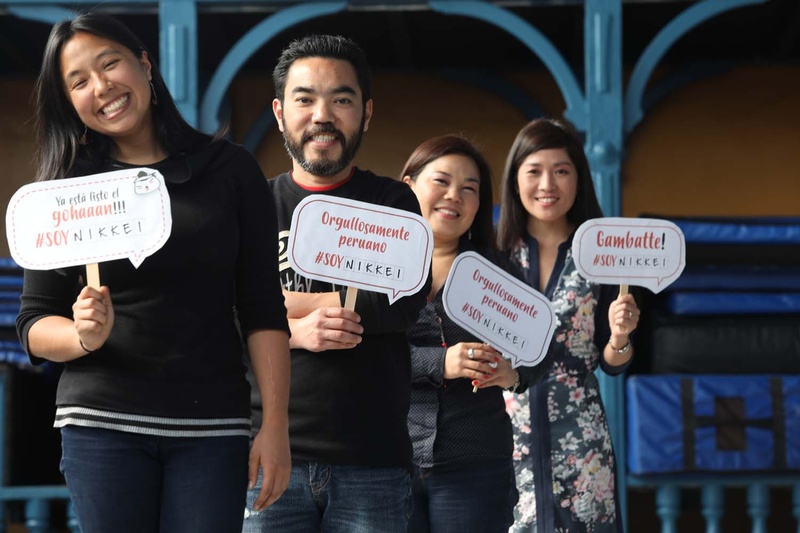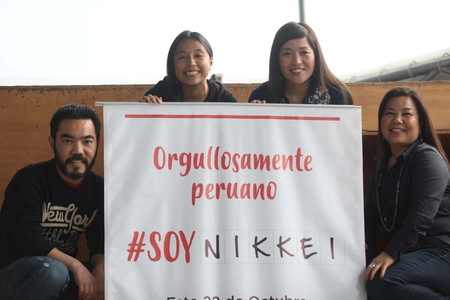On the occasion of the National Censuses that were carried out in Peru in October 2017, a group of Nikkei from different professions created a space for reflection with the “I am Nikkei Peru” campaign, which took advantage of social networks, the media and different spaces to sensitize the Peruvian-Japanese community with its identity.
Caroline Gibu, Geraldine Sakuda, Alexis Sakuda and Yuriko Tanaka make up this group that had its first meeting at the end of September, after Caroline raised a series of doubts about the census question on “ethnic self-identification”, which allowed everyone to Peruvians could exercise their right to define and identify themselves according to their ancestors, origins or customs.
For Gibu, this approach was valuable because it helped each person reflect on their identity and feel proud of it.
The omission of the Nikkei as an alternative answer to the question about ethnic self-identification caught the attention of Gibu and some of the friends he contacted, including Geraldine Sakuda.
“We asked ourselves what we could do because the card was already printed and it was not a question of complaining, we did not think of the campaign as a means of protest,” explains Geraldine, who indicates that one of the first things they did was meet to reflect on the fact. of being a Nikkei and from there defining a strategy that would not cause confusion. “It was not a campaign to win more 'votes',” he clarifies.
When talking about ethnicity instead of culture, doubts arose about the most appropriate term (Oriental, Asian, etc.), especially among Japanese migrants who may have another vision of their identity, since the idea of return, something that changed with the following generations. “We asked ourselves what we could contribute as Peruvians and what we could create in the future,” says Alexis.
“It was a complex job to analyze the question and what option we wanted to disseminate so as not to give an idea of exclusion,” he adds.
Something crucial was the fact that a tradition and the contribution that the Peruvian Japanese community has already left in the country was recognized. “We believe that it is something that was evident in the comments they made on the fan page, where many wondered why the Nikkei were not there,” says Geraldine.
Identity and recognition
Yuriko Tanaka is one of the youngest of this group and says that looking at herself to define herself has been an interesting process. It has also served to think about identity and certain concepts such as determinism. “They always call me Chinese and now I say I'm Nikkei. Another comment is that I must surely know about technology,” he says, laughing.
For Yuriko, in today's society there is a kind of positive discrimination against the Nikkei due to the contribution they have had as a community.
Gibu points out: “There is a general recognition of the great contribution that the Nikkei community has had and has in Peruvian society, especially in sociocultural, academic, professional and business aspects. "This recognition allowed the campaign not to generate negative positions or transcend political issues that were not the object of the campaign."
100 THOUSAND NIKKEI
The expectation of this group was that around 100,000 Nikkei living in Peru could be counted, although the figures can be misleading. “The National Household Survey (ENAHO) asked a race question and got 300,000 Asian people, 1% of the population, but the question was different,” says Caroline. By April 2018, it is expected to have the complete data of this registry, which has not been carried out since 2007, when 27,412,157 Peruvians were registered.
After knowing the results, the next step proposed by these young Nikkei is that the figures can be used so that more Nikkei can continue contributing more and more to society by preserving and disseminating the values transmitted by Japanese migrants, "so that the Nikkei continues being seen as something positive and desirable, and that we achieve a more just, inclusive and supportive country.”
* This article is published thanks to the agreement between the Peruvian Japanese Association (APJ) and the Discover Nikkei Project. Article originally published in Kaikan magazine No. 113, and adapted for Discover Nikkei.
© 2018 Texto y fotos: Asociación Peruano Japonesa











